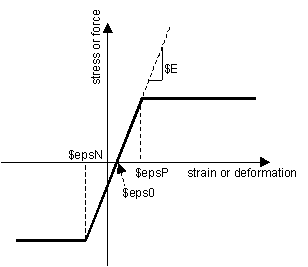Elastic-Perfectly Plastic Material: Difference between revisions
Jump to navigation
Jump to search
No edit summary |
No edit summary |
||
| Line 4: | Line 4: | ||
{| | {| | ||
| style="background: | | style="background:lime; color:black; width:800px" | '''uniaxialMaterial ElasticPP $matTag $E $epsyP <$epsyN $eps0>''' | ||
|} | |} | ||
Latest revision as of 17:43, 20 September 2012
- Command_Manual
- Tcl Commands
- Modeling_Commands
- model
- uniaxialMaterial
- ndMaterial
- frictionModel
- section
- geometricTransf
- element
- node
- sp commands
- mp commands
- timeSeries
- pattern
- mass
- block commands
- region
- rayleigh
- Analysis Commands
- Output Commands
- Misc Commands
- DataBase Commands
This command is used to construct an elastic perfectly-plastic uniaxial material object.
| uniaxialMaterial ElasticPP $matTag $E $epsyP <$epsyN $eps0> |
| $matTag | integer tag identifying material |
| $E | tangent |
| $epsyP | strain or deformation at which material reaches plastic state in tension |
| $epsyN | strain or deformation at which material reaches plastic state in compression. |
| (optional, default is tension value) | |
| $eps0 | initial strain (optional, default: zero) |
Code Developed by: fmk
